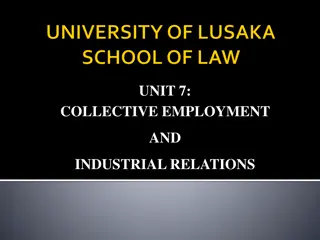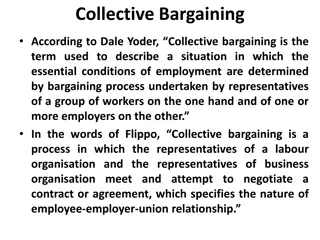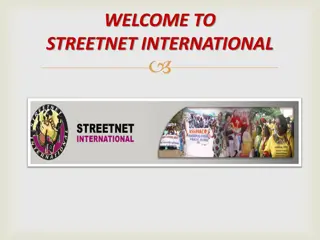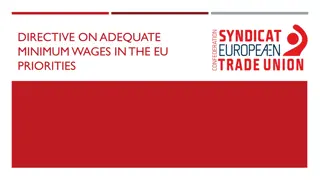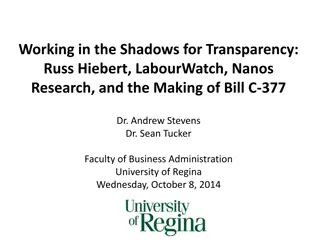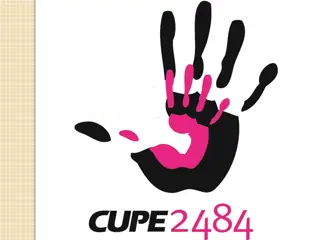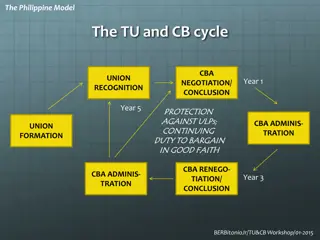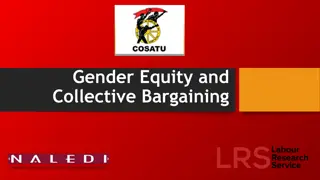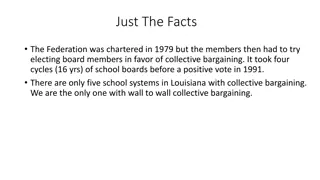Collective Bargaining and Trade Unionism in Recent Years
This article from Panteion University delves into the evolution of collective bargaining and trade unionism in Greece in recent years, offering valuable insights and analysis.
Download Presentation

Please find below an Image/Link to download the presentation.
The content on the website is provided AS IS for your information and personal use only. It may not be sold, licensed, or shared on other websites without obtaining consent from the author.If you encounter any issues during the download, it is possible that the publisher has removed the file from their server.
You are allowed to download the files provided on this website for personal or commercial use, subject to the condition that they are used lawfully. All files are the property of their respective owners.
The content on the website is provided AS IS for your information and personal use only. It may not be sold, licensed, or shared on other websites without obtaining consent from the author.
E N D
Presentation Transcript
Greece Collective bargaining and trade unionism in recent years Christina Korkontzelou and Dimitra Kofti, Panteion University of Social and Political Sciences
Previous context Collective bargaining over the years Coverage: from over 90% in 1990s to around 25% nowadays Decentralization Decrease in the number of sectoral and occupational CLAs Prevalence of enterprise-level bargaining and individual employment contracts Rise in atypical/flexible forms of employment
Power resources for trade unions Structural Power Long-term neoliberalization processes Debt crisis and austerity policies imposed by the Memoranda (2010-2018) Rise in unemployment, in flexible/informal forms of work (Kouzis 2016, Kapsalis and Kouzis 2020) Institutional Power Changes in the previous collective bargaining legal framework due to Memoranda. The case of the National General Collective Agreement Impact of recent labour laws (4635/2019, 4808/2021) the restriction of the favourability principle and the right to extension for sectoral CLAs + the restriction of the right to strike (Zisimopoulos 2019, 2022)
Organizational Power Decline in trade union density (around 20% in 2016) Decline in Confederations membership (Katsoridas 2021) Fragmentation of trade union landscape at lower levels grassroots trade unions Societal Power Overall absence of coalition-building initiatives and campaigns to attract members by the Confederations (Bithymitris and Kotsonopoulos 2018) Bureaucratization and governmental trade unionism (Vogiatzoglou 2018a) Big range of experimental practices at lower levels by primary/grassroots trade unions during the crisis (Vogiatzoglou 2018b)
Protest event analysis (PEA) findings important mobilizations in 2021 and 2022 Four general cross-sectoral 24h strikes in May and June 2021 against the anti labour law 4808/2021 introduced by the New Democracy government Nationwide mobilizations of the healthcare sector trade unions, demanding budget increase for the public healthcare system, health and safety measures at work for Covid- 19, throughout 2021-2022 Nationwide protests of the education sector trade unions throughout 2021-2022, against the external evaluation procedure in public schools and the educational reforms in higher education. Coalition building with students and citizens associations Mobilizations of the platform delivery drivers at enterprise and sectoral level, resulting in the creation of an enterprise trade union Seven 24h consecutive strikes by dockworkers and maritime workers trade unions in Piraeus Port, demanding health and safety measures at work and conclusion of CLA
Assessment of impact Important role of trade unions in organizing industrial actions. Increase in private sector mobilizations when compared to previous years. Geographical limitations in protest activity Limited initiatives taken by the two main Confederations (GSEE and ADEDY), despite big organizational capacity and resources Adoption of disruptive action repertoire (strikes, rallies, demonstrations) by trade unions, with successful outcomes inter-sectoral and cross-sectoral solidarity
Interviews: main challenges in collective bargaining and collective action Consensus of all interviewees on the partial rejuvenation of CB negotiations after the pandemic, but: Collapse of previous CB framework during the Memoranda, with ongoing effects (e.g. the determination of the minimum wage by the Minister of Labour) Restrictive current legislative framework (e.g. the extension clauses for CLAs, changes in arbitration and the right to strike, overtime work) Unwillingness / demotivation of employers to participate in employers organizations and CB
Representativeness and legitimacy concerns (existence of employer-friendly unions, fragmented trade union landscape) Clash of strategic political visions within the trade union movement (critique to the Confederations by primary trade unions , SMOs and leftist political parties). Lengthy negotiations, concession bargaining trends Labour transformations of recent years. Flexibilization of labour relations in different sectors, resulting in wage dumping practices and difficulties in applying existing CLAs or concluding new ones. Subcontracting practices and digitalization effects, which may impede the efficacy of strike actions
Conclusions Successful mechanisms for collective action and CB improvement (based on the mapping of successful practices) Militant leadership and persistent industrial actions, prioritizing class-based interests, are important for exerting pressure on big employers (e.g. dockworkers, call centers) Participation in social movements can broaden the demand agenda of trade unions and connect them with more diverse societal actors (e.g. artists sectors) Coalition-building between main trade unions and grassroots unions can indicate a path towards the overcoming of organizational fragmentation (e.g. delivery drivers) Participatory and democratic culture within the unions, based on the engagement of all members (e.g. researchers and higher education employees) Exploration of bottom-up, unofficial bargaining practices, in case of insufficient institutional power (e.g. dancers sector)







